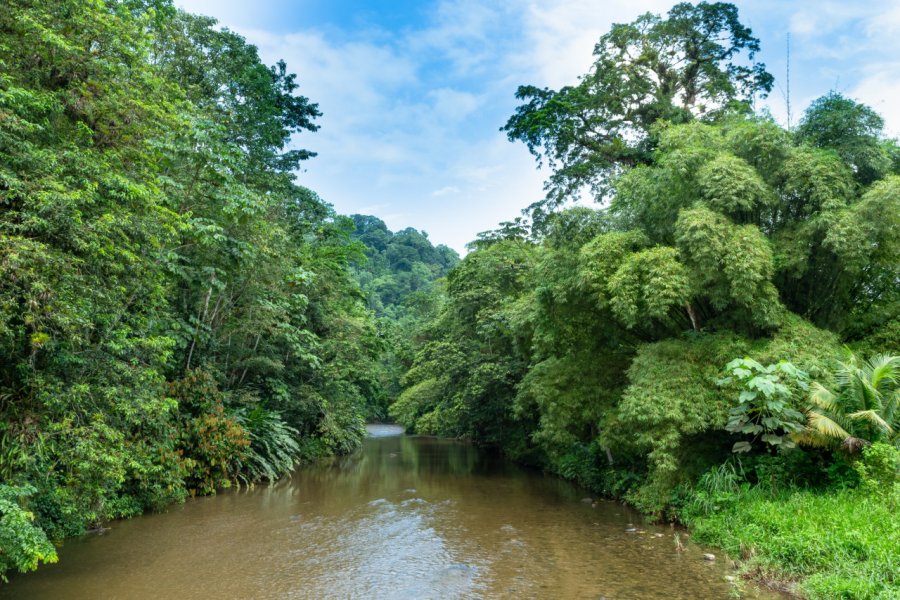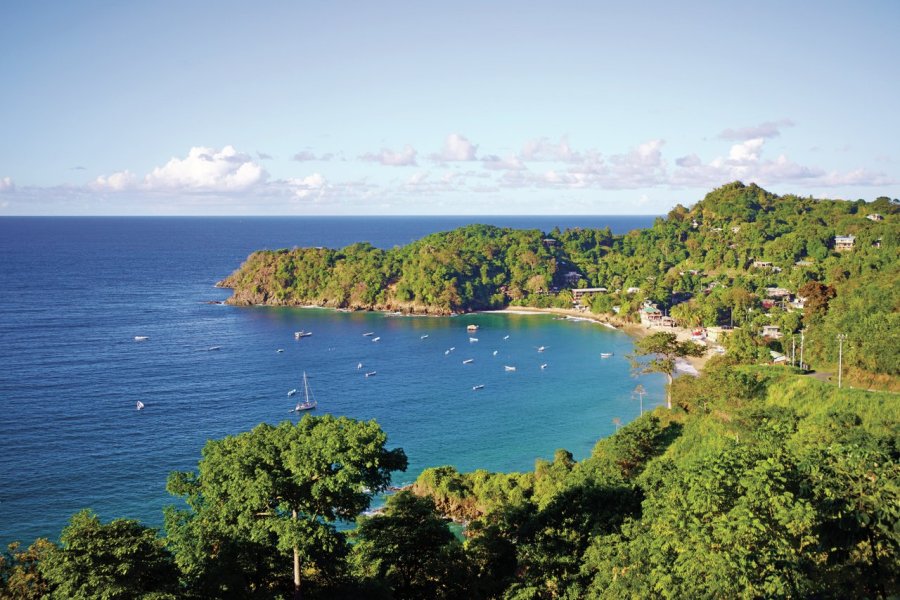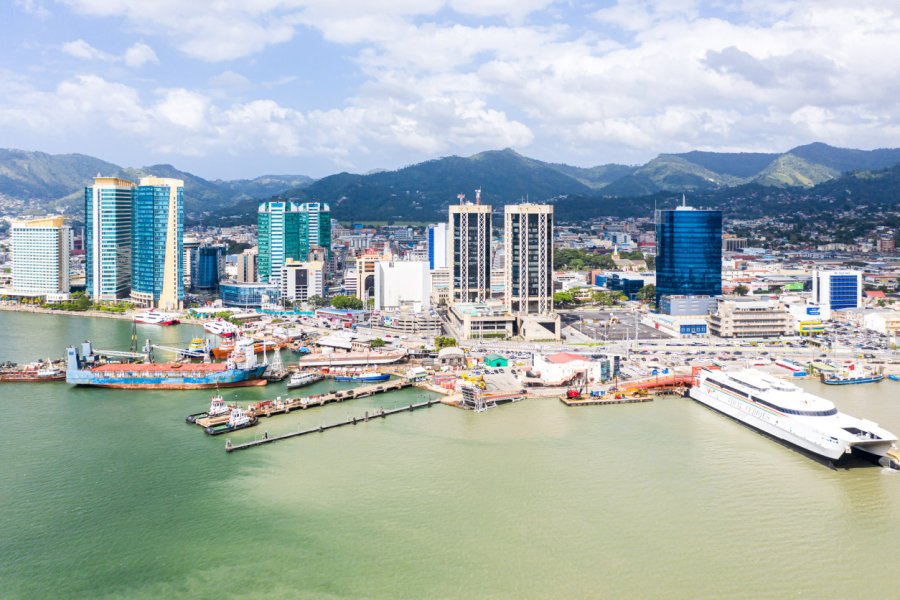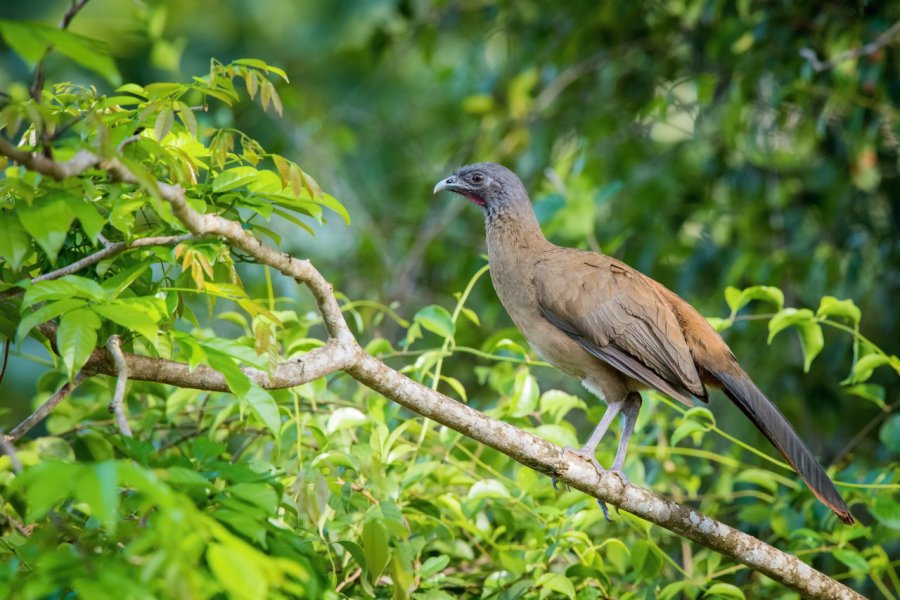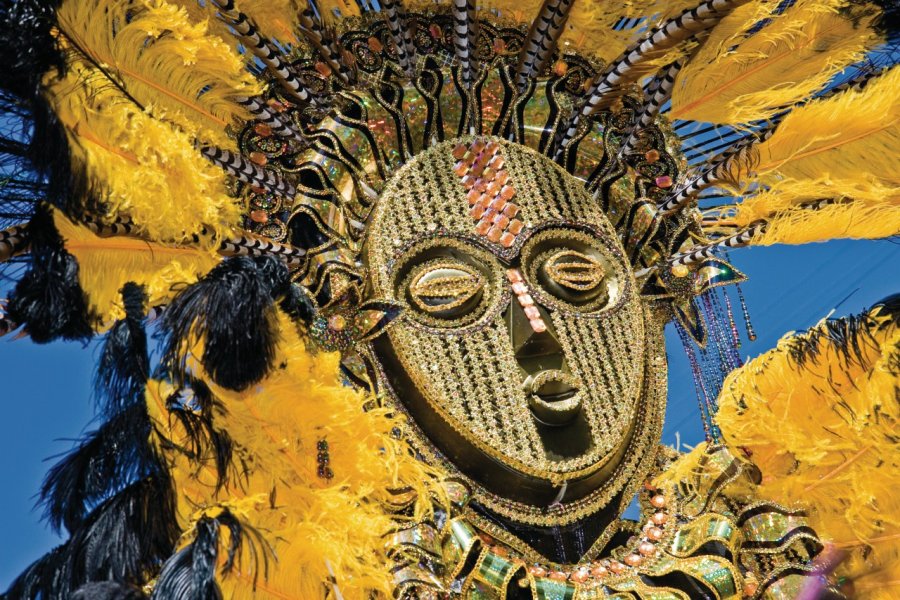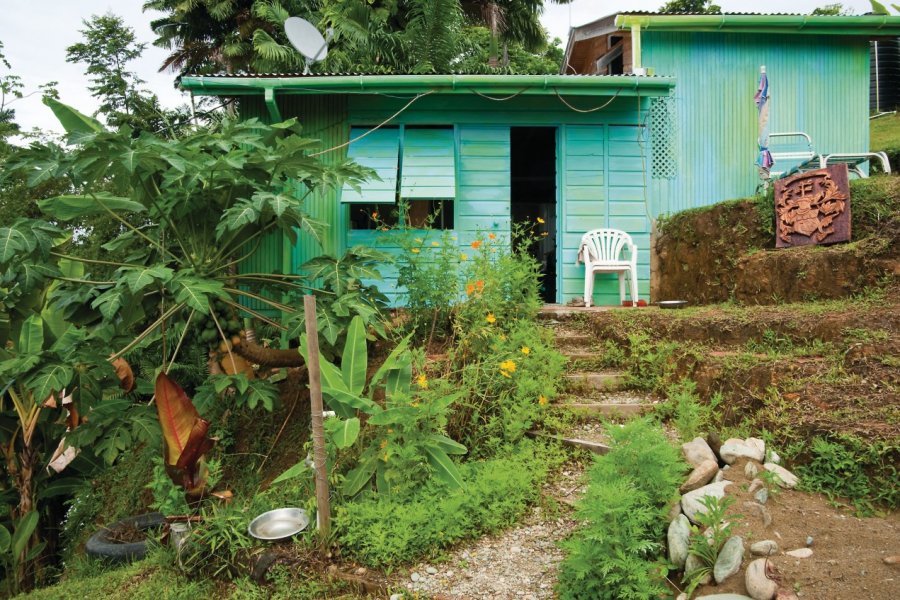Travel guide Trinidad & Tobago
Trinidad & Tobago are located off the Venezuelan coast in the Caribbean. In this travel guide, discover why these twin islands are an intoxicating destination not to be missed. A natural palette of dazzling colors, Trinidad, where golden sand meets the deep blue of the ocean, the white foam of the waves and the emerald green of the jungle, seems to have remained timeless since the days of Christopher Columbus. Here, in an unspoilt sanctuary, giant tortoises continue their ancestral ritual of egg-laying, a spectacle of nature that has endured for centuries. Despite its small size, the diversity is staggering. Dense jungles cover secret valleys, while steep hills and winding rivers are home to hundreds of waterfalls. Mysterious swamps and mountainous forests are populated by exotic fauna: howler monkeys, armadillos, emperor butterflies, parrots and orchids. A true paradise for naturalists.
Tobago, meanwhile, is a veritable archetype of the treasure island, having potentially inspired Daniel Defoe for his famous Robinson Crusoe. With over 70 sandy beaches, virgin forest, lagoons and coral reefs with turquoise waters, the island is a paradise for flora and fauna. Its fascinating history and African traditions have been preserved by a predominantly Creole population.
Trinidad & Tobago 's unique identity is the result of an exceptional cultural mix, uniting Amerindian, African, European and Indian heritages. Carnival, celebrated in February or March, is an explosion of color, music and dance. It is enlivened by steel bands and calypso. They reflect the richness of this cultural fusion. It's one of the most beautiful celebrations in the world, a fairy tale that transforms these islands into one huge party! Trinidad, the larger of the two islands, is a bubbling cultural melting pot. Its capital, Port-of-Spain, is a blend of colonial and modern architecture. Don't miss a visit to the National Museum and Art Gallery, where the island's history comes to life.
Naturally beautiful, the island offers unforgettable excursions to the Asa Wright Nature Reserve or the Main Ridge Forest, the oldest protected forest reserve in the Western Hemisphere. You'll be dazzled by Maracas Bay, where Atlantic waves meet golden sand.
Tobago, smaller and quieter, is a paradise for wildlife and diving. Buccoo Reef, with its crystal-clear waters and abundant marine life, is a world-class dive site. Pigeon Point, with its white sand and turquoise waters, is the very image of Caribbean perfection.
The history of these islands is as rich as their land. First inhabited by Amerindians, they were colonized by the Spanish before coming under British control. This complex past has left a diverse cultural heritage, visible in the local cuisine, an exquisite blend of African, Indian, Creole and European flavors.
Trinidad & Tobago is also a place to discover if you're passionate about birds, with exotic species in sanctuaries such as the Caroni Bird Sanctuary. Finally, for the adventurous, exploring the mystical caves of Gasparee in Trinidad is an experience not to be missed.
Pack your bags! Our Trinidad & Tobago travel guide will take you on a sublime and unforgettable Caribbean getaway! Discover the islands' best restaurants and hotels, as well as all the not-to-be-missed sights!
What to see, what to do Trinidad & Tobago?
-
Book an activity
-
Customized travel
- The most beautiful cities Trinidad & Tobago
When to go Trinidad & Tobago ?
When to go to Trinidad & Tobago for an unforgettable Caribbean experience? The best time to go to Trinidad & Tobago varies according to your desires, whether for the climate, the festivities or the peace and quiet.
January to March : this is the high season for the Trinidad Carnival, a festival of music and dance. The weather is dry and sunny, so you can enjoy the beaches and hiking.
April : temperatures are still pleasant, and it's a quiet period, ideal for enjoying the islands' landscapes without the crowds.
May to June: the onset of the rainy season brings cooler weather and lush landscapes. It's the perfect time to discover nature, with its flora and fauna in full bloom.
July to August: time for local festivals, such as the Tobago Heritage Festivalwhere you can discover the island's culture and traditions.
September to October: the rainy season continues, but it's a quiet time to visit, with lower prices and fewer tourists.
November to December: the end of the year sees the return of the dry season, ideal for those seeking to escape the cold of the northern hemisphere.
Whether you want to attend Carnival in February, explore the forests in June, or enjoy the tranquil beaches in October, every month in Trinidad & Tobago offers something new.
Suggested addresses Trinidad & Tobago
Travel Trinidad & Tobago
-
Find a hotel
-
Car Rental
-
International e-SIM package
-
Find a local agency
Un séjour à Trinidad & Tobago peut s'étaler sur une durée très variable en fonction de votre disponibilité bien sûr, mais d'abord de vos intérêts principaux. Pour un séjour court, on privilégiera Tobago, plus simple à découvrir et où on ne passe jamais bien longtemps dans un embouteillage contrairement à Trinidad où la circulation est souvent compliquée, surtout pour atteindre Port of Spain. Si vous disposez de plusieurs semaines, il faut prévoir un circuit vous permettant de découvrir les attraits de ces deux îles. Ne ratez pas le Sud de Trinidad, peu visité mais qui recèle de belles pépites, comme le Pitch Lake, un des trois seuls lacs de bitume au monde. Les amoureux de la randonnée prévoiront de visiter le Nord de Trinidad et s'ils sont courageux, feront le superbe sentier qui relie Matelot à Blanchisseuse avec une nuit de Bivouac. N'oubliez pas non plus que les tortues viennent pondre de Mars à Août !
Find unique Stay Offers with our Partners
How to go Trinidad & Tobago
How to go alone
Going alone to Trinidad and Tobago? Here's how to fill your travel diary:
Make a list of must-sees like Queen's Park Savannah in Trinidad or Pigeon Pointin Tobago, but leave room for improvisation. Sometimes, the best discoveries are made off the beaten track!
Language and immersion: learn a few Trinidadian Creole phrases to break the ice with the locals. English is the official language, but a little effort in Creole is appreciated.
Getting around like a local: opt for the colorful maxi-taxis typical of Trinidad & Tobago, for an authentic and affordable transport experience. In Tobago, cycling is also a great option for exploring beaches and coastal villages.
Safety and caution: ask locals for advice on places to avoid, especially if venturing out alone at night. Always be careful with your personal belongings.
Local connections: join a lime, a social gathering, or visit a pan yard where steelbands practice to experience Trinidadian culture.
Trinidadians and Tobagonians are known for their warm welcome, and a simple conversation can turn into an invitation to a family meal or village party.
How to go on a tour
Want to discover Trinidad & Tobago without worrying about the details? Organized travel is the key!
Find an agency that knows the Caribbean inside out. They'll take you where the hearts of Trinidad & Tobago beat the loudest, from Tobago's heavenly beaches to Trinidad's wild carnival.
Take a good look at the program! You want to see the must-sees, don't you? Make sure they're all on your itinerary.
A good guide can make all the difference. Find those who know Trinidad & Tobago like the back of their hand and share their passion.
How to get around
Discovering Trinidad & Tobago is a thrilling adventure! Here are a few tips for getting around these Caribbean islands with ease:
Colorful buses: public transport is an economical and authentic way to get around, especially in Trinidad. They let you experience the island at the local pace.
Car rental: to reach remote areas, car rental is an excellent option, especially in Tobago, where distances are shorter.
Cabs: available everywhere, cabs are convenient, but don't forget to negotiate the fare before you leave.
On foot or by bike: for shorter distances and more intimate explorations, nothing beats a good walk or bike ride, especially in small towns and seaside areas.
Ferries are available to travel between Trinidad and Tobago, and they also offer magnificent sea views!
Featured articles Trinidad & Tobago
Discover Trinidad & Tobago
There's much more to Trinidad & Tobago than its immense white sandy beaches, rich underwater fauna and flora, and dense tropical forests. In fact, Trinidad & Tobago is one of the Caribbean countries to have undergone the greatest number of alternative colonizations, from the English to the French, via the Spanish, the Dutch and many others. These various stages in the country's evolution now offer us a great diversity of origins, cultures and religions, with their own specific celebrations and arts. Trinidad & Tobago also boasts a huge biodiversity both on land and under the sea, which alone can be the main theme of your trip. In the following section, we'll try to help you discover the many historical, cultural and geographical facets of this little-known country, not forgetting its Carnival, considered to be one of the most beautiful in the world.
Pictures and images Trinidad & Tobago
The 12 keywords Trinidad & Tobago
1. Bacchanal
The soul of carnival. The moment when, under the influence of music, anything becomes possible. In a country where slavery has left deep traces in the cultural heritage, the bacchanal still has a high symbolic value, even if the term now tends to designate the importance of the party rather than its subversive risks.
2. Bake & shark

Comprising fried flatbread ( bake) and fried shark meat(to protect the sharks, ask for the fish version), this Trinidadian dish is the specialty of Maracas beach. The shark meat is marinated with herbs before being fried, and various ingredients such as lettuce, tomatoes, pineapple and ketchup are added.
3. Calypso
The traditional languorous rhythm of the islands is inherited from the period of slavery, when slaves challenged each other with humorous or polemical verses set to the rhythm of clapping sticks. This oratorical jousting has evolved into more elaborate music with guitars and drums, enriched by the influences of African rhythms.
4. Cascades
Who doesn't have in the back of their mind the image of one of those tropical island waterfalls featured and extolled in the advertising of certain shower products? Well, no, these waterfalls are no fantasy. In fact, there are dozens of them in Trinidad & Tobago. And just like in the ads, you can actually swim in them.
5. Do you play Mas ?
Every carnival season, this is the ritual question, and you'll inevitably be asked it at this time of year. Because there's one thing Trinidadians know well, and take pride in, and that's that you can't just watch carnival. The best way to participate is to play mas: "play the masquerade".
6. Gingerbread

Literally, gingerbread. The term refers to the small Victorian houses built of painted wood at the end of the 19thcentury, many of which can still be seen in San Fernando or Port of Spain. In the end, the term is well chosen, as some of them are reminiscent of the gingerbread house in the Hansel and Gretel fairy tale.
7. Good day
In Trinidad & Tobago, we greet each other by saying "Good day" at any time of the day. It's much easier than knowing when to use morning , afternoon or evening! But be careful, once the sun goes down, no more "Good day" but a "Good night" if you want to pass for a local and not a tourist.
8. Liming
Liming, which could be translated as "idleness", is an art form in Tobago. The expression comes from the custom of sitting under a lemon tree for a siesta, with nothing to do but squeeze lemons to garnish rum-based cocktails, no doubt. Favorite weekend activity.
9. Oil - Pétrole

Trinidad & Tobago's good fortune, if not its life insurance. In any case, it's a guarantee of good, long-lasting health for the GNP of both islands, so immense are the deposits of natural resources. There's oil, but also natural gas, which promises a prosperous if not ecological life for the nation in the years to come..
10. Rum shop
The rum shop is an institution. It's the place par excellence for socializing and liming. There isn't a village or hamlet that doesn't have its own rum shop. They usually take the form of small stalls with a bar, and often a terrace equipped with a few tables and chairs. Rum and music, what more could you ask for?
11. Steelband
The soul of Trinidad. That of the polyphonic orchestras that came from the ghettos of Laventille to play calypso or even J. S. Bach on recycled oil drums, winning not only the esteem of themselves, but also the pride of an entire people. Steelbands train year-round for carnival competitions.
12. Steelpan

The steelpan is Trinidad & Tobago's national musical instrument, and one of the last to be invented by man. It's made from a 160-litre oil drum, hammered and shaped to produce around 30 notes. Calypso is played on it, but not exclusively. Try visiting a factory!
You are from here, if...
You love the brassy sounds of calypso. This local music is omnipresent at festivities.
You love bake & shark, the inexpensive sandwich made with shark (less and less so these days, when it's often replaced by fish).
You like to spend a relaxing moment with your feet in the sand, sipping a good local rum as you watch the sun set over the ocean.
At weekends, you can be found on a white sand beach, liming oblige!
You love eating delicious taro in all its forms.
You start thinking about next year'scarnival as soon as you finish this year's edition.
Every member of your family has their own car. The traffic jams to get to Port of Spain are epic.
You don't get up immediately after your plane lands. Tobagonians are so tall that they get up at the last moment to leave the plane without staying bent over for an eternity.

